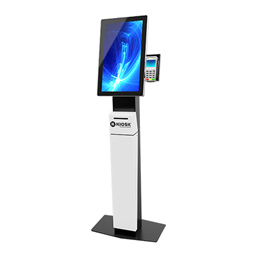There can be many reasons for selecting one operating system over another. During the process of choosing your operating system, you will want to consider the following questions.

Windows-based Apex kiosk with payment capabilities from KIOSK Information Systems
For which OS is the kiosk application available?
If you are running an application on a kiosk in kiosk mode or using kiosk software, the deciding (or limiting) factor can be the operating system upon which the app runs. Kiosk mode is a method or mode utilized for limiting user access and behavior. Windows kiosk mode, Android single app mode, and iOS kiosk mode all function to limit the device to allow access to only a specific application. The app availability will limit the OS options available to choose from. Most apps are available across multiple operating systems or are browser-based and can be run in any kiosk browser (found in kiosk software) on any operating system.
Which external devices are needed for the kiosk?
Like the application, certain external devices may only be available for a single operating system. Traditionally, those devices were Microsoft Windows-based and required a Windows OS in order to integrate. In more recent years, Bluetooth and cloud-based technologies have increased the number of options available for iOS and Android solutions as well. Kiosk devices such as credit card readers, barcode readers, receipt printers, facial recognition devices, and accessibility keypads are typically not available across all operating systems. Many use APIs available only for Windows devices. In most cases, the devices that do work with iOS and Android operating systems require an internet connection in order to communicate and do not work locally, as Windows options do.
Payment Devices
In the case of Android and iOS, payment devices (such as credit card readers), communicate via the cloud, and communication is only available if there is an internet connection. However, if the app is a native Windows solution, the communication can be local (negating the need for a connection), which allows for accepting payment transactions when the device is offline. For payment devices, there’s greater flexibility and reliability with Windows-based apps in comparison with Android and iOS. With iOS and Android operating systems, connectivity as well as potential latency with cloud-based solutions that can cause potential points of failure.
As explained by Kim Kenney, President, KIOSK Information Systems
“The majority of our kiosks and devices are either Windows-based or compatible with Windows giving customers flexible and scalable interoperability. Our focus is on the customer and what we’re hearing is the need for future-focused, self-service solutions like kiosk technology that can adapt as organizations grow. Windows helps to enable this capability.”
Printers
Many printers now make use of onboard Bluetooth technology. This means that they may be compatible with iOS, Android, and Windows operating systems. However, Bluetooth options tend to be more expensive. Additionally, printer manufacturers have historically developed hardware with a Windows driver and may not have iOS or Android support.
Europay/Mastercard/Visa
From an EMV (Europay Mastercard Visa) compliance standpoint, there are more Windows solutions (both from a hardware perspective and from a payment solution provider selection) available. Future-proofing and backward compatibility are extremely important and Windows typically provides that support.. This means that when the OS is updated, often legacy programs will not work with the updated OS.
Rob Chilcoat of Unattended Card Payments writes,
“While I can typically find a payment solution to meet just about any kiosk project’s payment requirements, it is always easier when the application developer is working in Windows. There are so many more feature-rich, per-certified, payment solutions to choose from when working in Windows. When developing for Android or iOS the selection becomes much more limited, and their capabilities less robust.”
Kiosk accessibility?
Microsoft has invested heavily in infrastructure for accessibility on the Windows platform. In addition to OS support, there are more options for accessibility hardware and software. Freedom Scientific’s JAWS text to speech software, for instance, is available for Windows and Android. It can be highly customized for each kiosk implementation. Native Android and iOS solutions are not very customizable and are only updated when Android or iOS are updated. There are a variety of hardware input devices that can be used with Windows, such as keypads and keyboards. Some of these devices only have Windows APIs, so it is important to check with the manufacturer before selecting an operating system or device.
If accessibility seems like an afterthought for your kiosk experience, consider that over 20% of the United States identifies with having a disability. People with disabilities are an oft overlooked demographic with disposable income like anyone else.
Which OS provides a more secure kiosk experience?
Windows offers native kiosk security functions and kiosk management capabilities for both kiosk management and configuration. Kiosk security and features are available across multiple operating systems, but Microsoft has invested heavily in improving the setup, configuration, and management experience for kiosks. Kiosks running a Windows operating system are typically more easily monitored, updated, and managed remotely due to the extensive native Windows management tools. Android and iOS have not invested in this area as heavily, nor do their platforms offer the same robust focus on business support.
It’s important to consider a variety of factors from application, external devices, accessibility, features, and security, when selecting an operating system for a kiosk.
